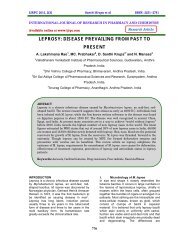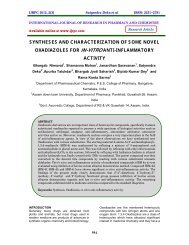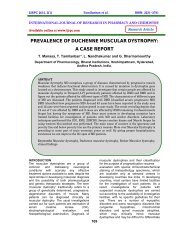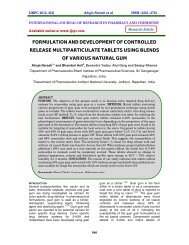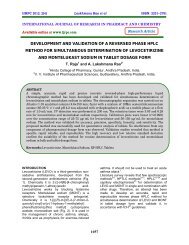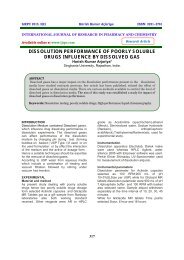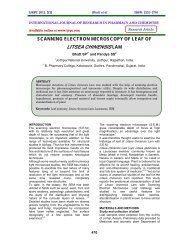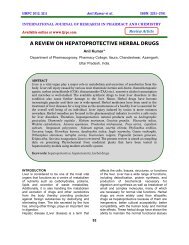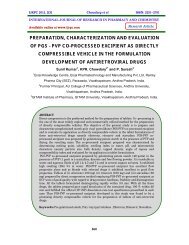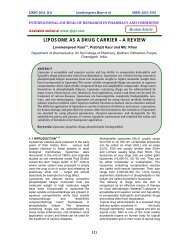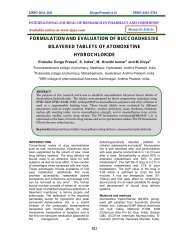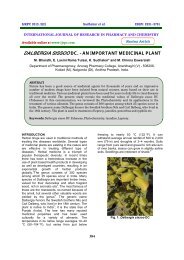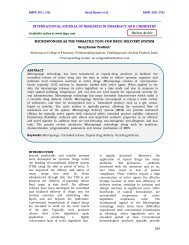microsatellite markers – a novel tool in molecular genetics - ijrpc
microsatellite markers – a novel tool in molecular genetics - ijrpc
microsatellite markers – a novel tool in molecular genetics - ijrpc
You also want an ePaper? Increase the reach of your titles
YUMPU automatically turns print PDFs into web optimized ePapers that Google loves.
IJRPC 2012, 2(2) Pokhriyal et al ISSN: 22312781<br />
Applications of Microsatellites 8<br />
S<strong>in</strong>ce <strong>microsatellite</strong>s are widely dispersed <strong>in</strong><br />
eukaryotic genomes, are highly variable, and<br />
are PCR based (requir<strong>in</strong>g only m<strong>in</strong>ute<br />
amounts of start<strong>in</strong>g template) they have been<br />
used <strong>in</strong> many different areas of research such<br />
as:<br />
1) Forensics 8<br />
Microsatellite loci, generally known <strong>in</strong> forensic<br />
applications as Short Tandem Repeat (STR)<br />
loci, are widely used for forensic identification<br />
and relatedness test<strong>in</strong>g, and are a<br />
predom<strong>in</strong>ant genetic marker <strong>in</strong> this area of<br />
application. They have also become the<br />
primary marker for DNA test<strong>in</strong>g<br />
<strong>in</strong> forensics (court) contexts -- both for human<br />
and wildlife cases (e.g. Evett and Weir, 1998).<br />
The reason for this prevalence as a forensic<br />
marker is their high specificity. Match identities<br />
for <strong>microsatellite</strong> profiles can be very high and<br />
the probability that the evidence from the<br />
crime scene is not a match with that of the<br />
suspect is less than one <strong>in</strong> many millions <strong>in</strong><br />
some cases. In forensic identification cases,<br />
the goal is typically to l<strong>in</strong>k a suspect with a<br />
sample of blood, semen or hair taken from a<br />
crime. Alternatively, the goal may be to l<strong>in</strong>k a<br />
sample found on a suspect's cloth<strong>in</strong>g with a<br />
victim. Relatedness test<strong>in</strong>g <strong>in</strong> crim<strong>in</strong>al work<br />
may <strong>in</strong>volve <strong>in</strong>vestigat<strong>in</strong>g paternity <strong>in</strong> order to<br />
establish rape or <strong>in</strong>cest. Another application<br />
<strong>in</strong>volves l<strong>in</strong>k<strong>in</strong>g DNA samples with relatives of<br />
a miss<strong>in</strong>g person. Because the lengths of<br />
<strong>microsatellite</strong>s may vary from one person to<br />
the next, scientists have begun to use them to<br />
identify crim<strong>in</strong>als and to determ<strong>in</strong>e paternity, a<br />
procedure known as DNA profil<strong>in</strong>g or<br />
"f<strong>in</strong>gerpr<strong>in</strong>t<strong>in</strong>g". The features that have made<br />
use of <strong>microsatellite</strong>s attractive are due to their<br />
relative ease of use, accuracy of typ<strong>in</strong>g and<br />
high levels of polymorphism. The ability to<br />
employ PCR to amplify small samples is<br />
particularly valuable <strong>in</strong> this sett<strong>in</strong>g, s<strong>in</strong>ce <strong>in</strong><br />
crim<strong>in</strong>al casework only m<strong>in</strong>ute samples of<br />
DNA may be available.<br />
2) Population Studies 8,9<br />
By look<strong>in</strong>g at the variation of <strong>microsatellite</strong>s <strong>in</strong><br />
populations, <strong>in</strong>ferences can be made about<br />
population structures and differences, genetic<br />
drift, genetic bottlenecks and even the date of<br />
a last common ancestor. It can also be very<br />
helpful <strong>in</strong> study<strong>in</strong>g the <strong>in</strong>heritance of the<br />
natural characters of an <strong>in</strong>dividual from its<br />
ancestor. It also reveals a significant<br />
<strong>in</strong>formation on the correlation of the<br />
<strong>in</strong>dividual’s genetic constitution with respect to<br />
its ancestor from which he has been<br />
descended.<br />
3) Conservation Biology 8,9<br />
Microsatellites can be used to detect sudden<br />
changes <strong>in</strong> population, effects of population<br />
fragmentation and <strong>in</strong>teraction of different<br />
populations. Microsatellites are useful <strong>in</strong><br />
identification of new and <strong>in</strong>cipient populations.<br />
It can be useful <strong>in</strong> identify<strong>in</strong>g the adaptation of<br />
an <strong>in</strong>dividual to the ever-chang<strong>in</strong>g environment<br />
and also its survival for the years <strong>in</strong> the same<br />
environment.<br />
4) In Mapp<strong>in</strong>g genomes 8,9<br />
They are very much helpful <strong>in</strong> mapp<strong>in</strong>g of<br />
genome and f<strong>in</strong>d<strong>in</strong>g or locat<strong>in</strong>g the significant<br />
portion <strong>in</strong> the genome of an <strong>in</strong>dividual. They<br />
have found wide applications <strong>in</strong> areas such as<br />
the widely publicized mapp<strong>in</strong>g of the hum<br />
an genome.<br />
5) In a Biological/Evolutionary context<br />
8,9<br />
They can also be used to address questions<br />
concern<strong>in</strong>g degree of relatedness of<br />
<strong>in</strong>dividuals or groups. For captive or<br />
endangered species, <strong>microsatellite</strong>s can serve<br />
as <strong>tool</strong>s to evaluate <strong>in</strong>breed<strong>in</strong>g levels. From<br />
there we can move up to the genetic structure<br />
of subpopulations and populations. They can<br />
be used to assess demographic history (e.g.,<br />
to look for evidence of population bottlenecks),<br />
to assess effective population size and to<br />
assess the magnitude and directionality<br />
of gene flow between populations.<br />
Microsatellites provide data suitable for<br />
phylogeographic studies that seek to expla<strong>in</strong><br />
the concordant biogeographic and genetic<br />
histories of the floras and faunas of large-scale<br />
regions. They are also useful for f<strong>in</strong>e-scale<br />
phylogenies upto the level of closely related<br />
species.<br />
6) Diagnosis and Identification of<br />
Human Diseases 10<br />
They serve a role <strong>in</strong> biomedical diagnosis as<br />
<strong>markers</strong> for certa<strong>in</strong> disease conditions. That is,<br />
certa<strong>in</strong> <strong>microsatellite</strong> alleles are associated<br />
(through genetic l<strong>in</strong>kage) with certa<strong>in</strong><br />
mutations <strong>in</strong> cod<strong>in</strong>g regions of the DNA that<br />
can cause a variety of medical<br />
disorders.Because <strong>microsatellite</strong>s change <strong>in</strong><br />
length early <strong>in</strong> the development of some<br />
cancers, they are useful <strong>markers</strong> for early<br />
cancer detection. Because they are<br />
polymorphic they are useful <strong>in</strong> l<strong>in</strong>kage studies<br />
which attempt to locate genes responsible for<br />
various genetic disorders.<br />
For example, <strong>in</strong> one part of chromosome<br />
number 4, CAG nucleotides are repeated<br />
many times over. They look like this<br />
CAGCAGCAGCAG....If the tri-nucleotides are<br />
409



